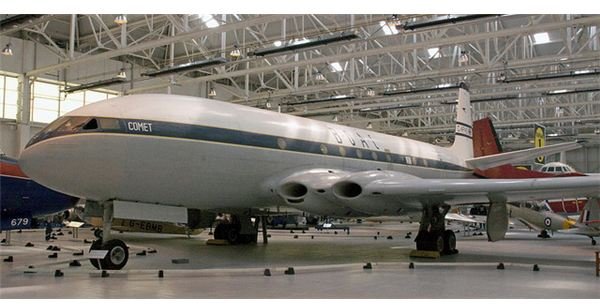De Havilland Comet: Historic Jet Airliner
The Comet’s Place in History
As the first jet airliner, the De Haviland Comet made airplane history. The Comet flew higher, faster and quieter than the propeller driven airliners of its era. The British were ahead in the development of jet engines after World War II and the Comet was several years ahead of Boeing and Douglas in the United States.
Unfortunately, the Comet is now remembered as an aviation disaster due to a string of accidents including midair disintegrations. The Comet was the first of its kind, and it taught the aircraft manufacturing industry some hard learned lessons.
The Rise of the De Havilland Comet
At the end of World War II, Great Britain was a leader in the new technology of jet propulsion. The De Havilland company had produced fighter and other military aircraft during the war. Included in the wartime production was the Vampire, one of the first jet fighters. De Havilland decided to use their aircraft building and jet engine expertise to produce a new kind of commercial airliner.
The De Havilland Comet first flew in 1949 and entered commercial service in 1952. The Comet was a revelation for travel. Most people still traveled by train or ship and the available commercial planes were of designs from before the war. The propeller driven aircraft of the era were noisy and uncomfortable. The Comet could fly at 40,000 feet above the weather at speeds approaching 500 mph. A pressurized, air-conditioned cabin made air travel pleasant and fast. The Comet initiated a new era in travel.
By May 1953, De Havilland had firm orders for 50 Comets and was negotiating more sales. Executives from Boeing and Douglas in the U.S. were afraid the British would control the commercial airliner business for many years to come.
The Fall of the Comet
Accidents started to plague the Comet in 1953. The early incidents involved failures to takeoff. It was determined the airplane was not generating enough lift in low speed, heavy weight conditions. Modifications were made to improve the low speed performance of the aircraft. These early incidents did not reduce the public enthusiasm about the Comet.
In 1954, two accidents changed the way the Comet was perceived. In January of that year a plane climbing out of Rome to a cruising altitude of 36,000 feet disintegrated between 26,000 and cruise altitude. The Comets were grounded and modifications were made, even though De Havilland did not know the exact cause of the accident. Unfortunately, just two weeks after the Comets resumed flying another plane came apart climbing to 36,000 feet.
To find the cause of the accidents, De Havilland built a giant tank and submersed an entire Comet. In the tank the aircraft cabin was pressurized and the plane was subjected to the movement and pressure changes of thousands of hours of flight. It was discovered that stress points were forming at the corners of the square windows of the original Comet. The stress points would lead to failure in the integrity of the aircraft and total failure of the aircraft in flight.
It took four years for De Havilland to re-engineer the structure of the Comet including the installation of round windows. The Comet’s reputation was destroyed by effects and forces the plane encountered flying at speeds and altitudes that were a new frontier for aviation. By the time the improved Comet rolled out, the new Boeing 707 was in service and was to become the airliner of the new jet age.
References
Century of Flight: https://www.century-of-flight.net/Aviation%20history/coming%20of%20age/De%20Havilland%20Comet.htm
Aerospaceweb.org: https://www.aerospaceweb.org/aircraft/jetliner/comet/
Photo by ahisgett, Flickr Creative Commons attributions
